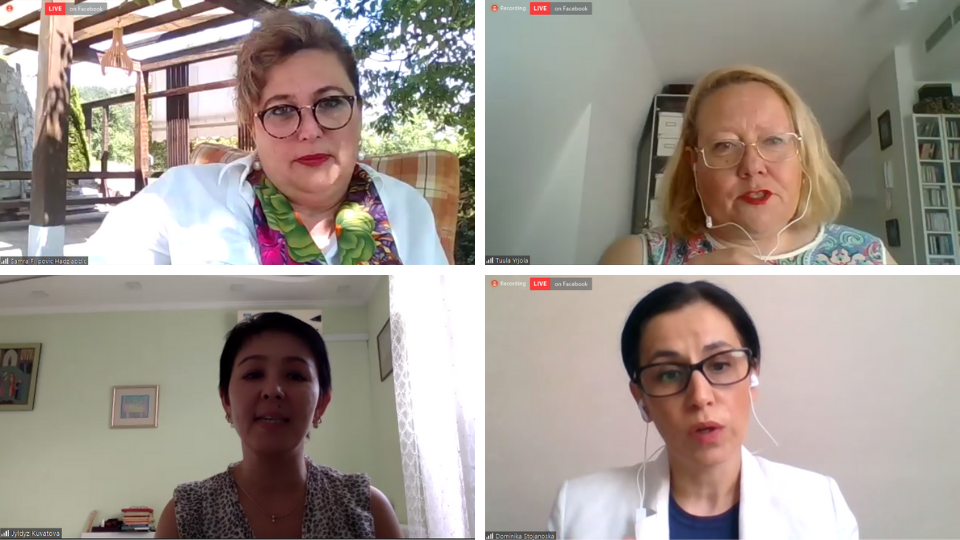Localizing the women peace and security agenda in the OSCE region
Date:

Around 140 participants from across Europe and Central Asia attended the webinar on ‘Implementing Women, Peace and Security: Localization in the OSCE Region’ on 1 July to discuss how to further develop and strengthen the local implementation of the women, peace and security agenda and the National Action Plans (NAPs). Organized by LSE, OSCE and UN Women, the webinar also marked the 20th anniversary of the UN Security Council resolution 1325 (UNSCr 1325) on women, peace and security.
Tuula Yrjölä, Director of OSCE Conflict Prevention Centre, kicked off the webinar by highlighting positive developments that a large majority of OSCE states have a NAP to implement UNSCr 1325 and Security Sector Institutions (SSIs) have developed a stronger commitment on women, peace and security, including increasing the number of women in SSIs. However, she noted that women were still invisible in security sector decision-making and in formal peace negotiation processes. Yrjölä also stressed the importance of localization: “It is critical to take National Action Plans beyond the national capital in order to respond to the local security needs,” she said.
During the webinar, OSCE and LSE launched the study ‘Implementing the Women, Peace and Security Agenda in the OSCE Region’, which examines the NAPs on UNSCr 1325 of OSCE participating states with case studies from Bosnia and Herzegovina, Kyrgyzstan, Moldova, Serbia and Ukraine.
Henri Myrttinen, researcher on the report, highlighted that the study found Local Action Plans (LAPs) on UNSCr 1325 highly beneficial as they respond better to localized needs with tangible results and broaden participation of local actors.
The study identified six pathways to localization of NAPs:
- Developing a women, peace and security action plan independently from “the ground up” based on localized gender and security analysis
- Top-down implementation of NAP through the local structures of national ministries or SSIs
- Integrating locally implementable activities into national level plans
- Copying activities from NAPs, adapting these and implementing them locally
- Integrating women, peace and security relevant aspects into existing or broader local gender equality implementation plans
- Implementing individual projects with relevance to women, peace and security but not directly tied to a plan.
Samra Filipović Hadžiabdić, Director of the Agency for Gender Equality in Bosnia and Herzegovina (BiH), emphasized that localization makes NAPs more meaningful to respond to human security needs, which must be better focused on a people-centered security approach and require better accountability for human rights violations. “Women are not sufficiently informed about their security needs. They are chronically underrepresented in local governance structures and can’t make decisions in local security issues. Security can be achieved only if women have a meaningful role,” said Filipović Hadžiabdić.
Jyldyz Kuvatova, Associate Professor at the American University of Central Asia, presented some challenges in the implementation of the UNSCr 1325 NAP in Kyrgyzstan, including lack of a national allocated budget and dependency on donor funding. On localization, she highlighted the importance to engage more broadly civil society organizations, including youth’s associations. “Young people are very underutilized assets and they have a huge potential. They can undermine patriarchy,” she said.
Dominika Stojanoska, Head of Office ad interim of UN Women in Ukraine, reported the findings of the UN Women Corporate Thematic Study on Implementation of NAPs on 1325, which found out a series of challenges, such as the allocation of a consistent budget among the 83 states currently implementing the UNSCr 1325, and the absence of solid monitoring and evaluation frameworks to assess their implementation and impact.
She highlighted that more efforts are needed to localize the NAPs in conflict settings where women and men experience safety and security challenges and scarce resources, as well as enhancing leadership and participation of women in local governance and decision-making processes. “To successfully localize the women peace and security agenda, we need to ensure women’s access to local governance and their participation in identifying the different needs and priorities of women and men, including the most excluded. Conducting gender and conflict- sensitive analysis are also key to ensure inclusive peace efforts,” emphasized Stojanoska. In Ukraine, UN Women is using an innovative approach by combining localization of NAPs with the decentralization process.
For more information:
LSE database on the women, peace and security National Action Plans: https://www.wpsnaps.org/
UN Women Global Study on the Implementation of UNSCr 1325: https://wps.unwomen.org/themes/
Report of the Secretary-General on women and peace and security: https://reliefweb.int/report/world/report-secretary-general-women-and-peace-and-security-s2018900